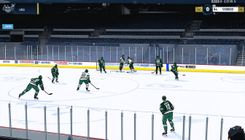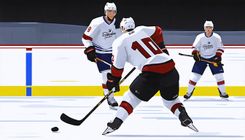NHL Collective Bargaining Agreement: New Prospects Development Pathway

The current NHL collective bargaining agreement (CBA) is set to expire in September 2026, a timeline that has historically raised concerns among stakeholders familiar with the sport's past labor issues. However, the NHL and the NHL Players Association have made notable progress this summer by agreeing on a new framework for the CBA. Although the full Memorandum of Understanding is not yet publicly available, key details have emerged, as reported by NHL insider Frank Seravalli.
A significant change within the new CBA framework will allow each NHL team to assign one 19-year-old prospect to their American Hockey League (AHL) affiliate each season. This adjustment could affect a maximum of 32 players annually, creating a noteworthy impact on the development of NHL prospects. Traditionally, under the existing Canadian Hockey League (CHL)-NHL agreement, prospects drafted from major junior leagues—such as the Ontario Hockey League (OHL), Western Hockey League (WHL), or Quebec Major Junior Hockey League (QMJHL)—are not eligible for assignment to the AHL or ECHL until they either turn 20 or complete four seasons in the CHL. However, players drafted from other junior leagues and subsequently joining a CHL team are exempt from this stipulation.
The new CBA is anticipated to come into effect for the 2026-2027 season, potentially benefiting players born in 2007, such as Vancouver Canucks prospect Braeden Cootes, who will turn 19 in February 2026. Should the Canucks determine that Cootes' development would be better served outside the WHL, he may be assigned to the Abbotsford Canucks that fall. Importantly, since the age requirement is predicated on being 19 and not by draft year, a newly drafted CHL player turning 19 shortly after the draft could transition directly to the AHL without returning to junior hockey. For instance, top prospect Ryan Roobroeck, born in September 2007, could sign his entry-level contract (ELC) and, if he remains at his NHL team's development camp, be assigned directly to the AHL rather than returning to the Niagara IceDogs of the OHL. This new rule opens a valuable development pathway that has long been needed in the sport. Historically, players like Dylan Strome faced challenges due to developmental misalignments, making this new option particularly relevant as it allows talented players to avoid stalling their careers.
Recent examples, including Cole Perfetti and Shane Wright, further illustrate the potential benefits of the new CBA. Perfetti played with the Manitoba Moose during the 2021 season when the pandemic disrupted his OHL campaign, while Wright was permitted to play with the AHL's Coachella Valley Firebirds in 2023 due to unusual circumstances surrounding his eligibility. These players showcased that in many cases, competing at the AHL level can enhance their development compared to returning to the CHL. The language used by insiders indicates that the regulation stipulates 'one player per organization per season,' suggesting that once a team assigns a 19-year-old, they would not be able to assign another unless the player is called up or returned to junior hockey. Nevertheless, it is uncommon for teams to have multiple pressing 19-year-old prospects simultaneously, making this consideration less likely to pose significant logistical challenges.
This amendment is generally advantageous for NHL teams, providing them closer proximity to evaluate and work with their top prospects. However, it may pose challenges for CHL teams, which rely on player retention for competitiveness. The one-player limit likely reflects the CHL's interests, as losing numerous elite prospects in a single year would be detrimental to junior leagues. This development could shift competitive balances, particularly for teams like the London Knights in the OHL, consistently recognized for their depth and success. The Knights' players could benefit from the AHL exposure, offering them a chance to confront greater challenges rather than bustling through junior competition without encountering adversity.
Additionally, there are possible advantages for players, including potential early access to arbitration rights for those opting for AHL assignments. Some NHL agents have indicated that many prospects may prefer the CHL-to-AHL transition—along with the associated signing bonuses—over returning to school or joining NCAA programs. The changing landscape of NIL regulations adds another layer to this equation, as fewer incentives may exist for players to pursue college hockey if the draw of NIL money diminishes. The incorporation of this new development pathway allows top CHL players the opportunity to accelerate their professional careers while also enhancing their skills through practical experience in a more competitive environment.









